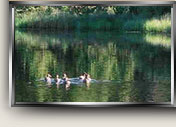Government Impact on the Riparian Environment
There are more laws and government agencies
concerned with the riparian area than with any other aspect of the
ranch. This section briefly describes legislation that affects the
ranch and identifies other legislation that might seem relevant but
does not actually affect the ranch. This section also identifies
government agencies that have jurisdiction and two agreements made
with Deschutes County. See the
Government Agency Appendix for more
information.
Federal Legislation
The Clean Water Act aims to restore and
maintain the chemical, physical, and biological integrity of waters
in the United States. Under this act, the state of Oregon has
listed the lower stretch of the Little Deschutes with the
Environmental Protection Agency for having low levels of dissolved
oxygen. As discussed in the
Stream Flows section, the oxygen is low
because water is accumulated in Crescent Lake over the winter and
released over the summer. There is no indication that the EPA will
take any action to alter the seasonal stream flow in the foreseeable
future.
The Endangered Species Act (ESA), with
subsequent court rulings, prohibits the “taking” of an endangered
species, including, in some cases, habitat modification. There are
no endangered species on the ranch.
The Wild and Scenic Rivers Act,
administered by the National Park Service, protects designated
stretches of river, including the top twelve miles of the Little
Deschutes. The act has no impact on the ranch.
State Legislation
The Scenic Waterways Act requires
approval by the Oregon Parks and Recreation Department for any new
activity by a landowner within a quarter mile of a designated scenic
waterway, including groundwater pumping. The Little Deschutes is
not a designated scenic waterway (even though it’s beautiful). The
parts of the Deschutes River that are designated scenic waterways
are not within a quarter mile of the ranch. The closest scenic
waterways are the Deschutes River from the gaging station below
Wickiup Dam to the General Patch Bridge and from Harper Bridge to
about three miles above the Colorado Street bridge in Bend.
The Instream Water Rights Act allows
owners of rights to
take water from rivers (generally farmers and irrigation
districts) to convey the rights (and the water) to instream flows in three ways. Permanent transfers and temporary
transfers (leasing) are the first two methods. The third,
relatively unique among western states, allows the holder of water rights to lease, sell, or transfer a portion of water the holder
conserves while continuing to satisfy the use for which the owner’s
rights were obtained (e.g to irrigate a given acreage). For example, water saved by lining irrigation
canals can be leased to the state or other entities and used to
increase the flow in the river. In the case of the Little
Deschutes, water conservation by farmers downstream and their
leasing out some of the conserved water means less water has to be stored
and released from Crescent Lake to support irrigation. Seasonal stream flow
can then more closely approximate the natural flow.
County Law and Agreements
County zoning law forbids building within 100
feet of ordinary high water. The ordinary high water mark is
usually the top of the river bank and seasonal high water often
rises above ordinary high water.
To develop Vandevert Ranch, the developer was
required to sign two agreements affecting natural resources with
Deschutes County.
The Willow Management Plan (in the
Appendices) allows the developer to remove 25% of the willows along
the river banks (i.e. within ten feet of the river) and 75% of the
willows in the riparian influence area back from the river. The
percentages apply to the willows shown in the 1979 aerial
photograph. Since many more willows have grown up since 1979, the
ranch could remove a great deal of willow while remaining within the
bounds of the agreement.
A Conservation Easement designates
limited areas along the river which are to remain undisturbed.
Government Agencies with Jurisdiction
Oregon Department of Environmental Quality (DEQ)
– Safeguards the quality of the water in the river.
Oregon Department of State Lands – Must approve
any destruction of wetlands (usually mitigated by the addition of
new wetlands nearby). The destruction of wetlands necessary to
build the ranch bridge was mitigated by the creation of wetlands
around the pond.
U.S. Corp of Army Engineers - Must approve
construction (e.g. bridges) in wetland areas and placement of
material in the river.
U.S. Fish and Wildlife Service – Designates the
wetland area.
Continue to Riparian Objectives
and Strategies
Return to
Stewardship Plan Table of Contents






